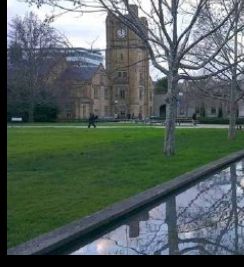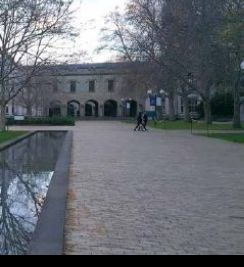
Physiology News Magazine
Member and lab profile: Samantha Passey, Pathogenesis of Chronic Lung Diseases Laboratory, Department of Pharmacology, University of Melbourne
Samantha Passey on moving to Australia, settling in to their scientific community and becoming a Research Fellow in muscle wasting associated with lung disease.
Membership
Member and lab profile: Samantha Passey, Pathogenesis of Chronic Lung Diseases Laboratory, Department of Pharmacology, University of Melbourne
Samantha Passey on moving to Australia, settling in to their scientific community and becoming a Research Fellow in muscle wasting associated with lung disease.
Membership
https://doi.org/10.36866/pn.91.46

Moving down under
It has been over a year since I last contributed an article for Physiology News. In my original lab profile I described the work that we were doing in the Muscle Cellular and Molecular Physiology Research Group at the University of Bedfordshire with Mark Lewis, aiming to generate neuromuscular junctions in 3D engineered skeletal muscle.
Well, things have changed a bit since then to say the least! Not only did the muscle group move to Loughborough University where Mark is now dean of the School of Sports, Exercise and Health Sciences but I have moved to the other side of the world and am now living in Melbourne, Australia!
This article is timely in that as I write it I am coming up to the 1 year anniversary of my move down under, and it seems a good time to reflect on the ups and downs of the past year and how my life has changed since making the move.
I arrived in Melbourne on Australia and New Zealand Army Corps day, a memorial day to commemorate the first military action by Australian and New Zealand forces in the First World War on 25 April 1915. It is a national holiday and is a day of remembrance for all Australian and New Zealand military lost in battle over the years. Expecting glorious sunshine and warm temperatures, I was somewhat surprised to receive a decidedly British welcome at Melbourne’s Tullamarine airport, with cool temperatures and rain alternating between heavy downpours and unceasing drizzle. Despite my soggy introduction, my first impressions of Melbourne were good; people are friendly and helpful and the city is great, different to the UK but in some ways very similar.
Renowned for having four seasons in one day, the weather is often very changeable but in general is warmer than the UK and often very hot, reaching 44 degrees celcius on a few isolated days this summer! The climate is therefore conducive to good outdoor lifestyle and the infamous Aussie BBQs, which are a far cry from my childhood images of undercooked sausages and dad standing in the rain under the umbrella trying to coax the BBQ coals to light!
Melbourne, voted most liveable city in the world in 2012, is a very vibrant city with plenty of things going on whatever your tastes. It is a hugely multicultural city with Italian, Greek, Asian and European populations, which also means there are some great restaurants; indeed Melbourne is known for its food and cafe culture.
Since I arrived the past year has been something of a rollercoaster with plenty of ups and downs. I began work at the University of Melbourne only a few days after arriving in Australia, and although to begin with things seemed to be going well, I soon came to realise that perhaps my new position was not quite the right ‘fit’ for me. To cut a long story short, after much agonising I decided to leave and find another position that would hopefully be a better fit for my skills and personality. A tough decision, but ultimately the right one I think – I took a few months off to settle in to Aussie life and have now started in a new position in the Department of Pharmacology at the University of Melbourne, which I am finding very enjoyable.
It has been a bit of a rollercoaster year, and it’s funny how much things have changed in just 12 months. Some things have been really hard and other things have been easier than expected. Leaving family and friends and knowing that going home to visit is not a trivial journey but a full 24 hour trek across the globe is difficult, but Skype helps tremendously with being able to see and speak to family members regularly. Other things have been much easier than I expected, such as setting up home in a new country and all the little things that have to be organised along with that. Many aspects of Melbourne life are similar to the UK and I think a little familiarity is good to help ease into life in a new country.
Looking back over the past year I am really glad that I made the decisions I made, despite the ups and downs. Moving across the world is a big step and it is daunting to think about combining the stress of moving to a new country and starting a new job. The fear of things not working out is very real. However, I now realise that even if things don’t initially work out the way you want there is always a way to change the situation, nothing is set in stone and just because something isn’t quite what you wanted that isn’t a reason to give up, pack up and go home. I’m now settling into my new position and excited about the research and future opportunities, and for now enjoying being part of the Melbourne scientific community and building new networks here in Australia.
The research landscape in Melbourne

From a science point of view, Melbourne is well equipped for research, having a number of universities and a host of private research institutes focusing on a range of different research areas such as cancer, neuroscience and infectious diseases. The University of Melbourne campus is located in the area of Parkville just north of the main city centre, and is in close proximity to the Royal Melbourne Hospital and the Royal Children’s Hospital and a number of research institutes, creating a scientific and academic hub of activity that is still close to the city centre. In addition the facilities seem to be expanding; over the road from the medical building where I am based are being built not one but two research centres, one for infectious diseases/immunology and another for cancer research.
Research funding is available from two major funding bodies, the National Health and Medical Research Council (NHMRC) and the Australian Research Council (ARC), with other smaller bodies offering research funds from local government or philanthropic sources. Fellowships are available for researchers at different stages of their careers or with different levels of postdoctoral experience, although as in the UK the competition is high and fellowships are only awarded to the best candidates. The university also offers a number of internal funding schemes, which seem to be excellent opportunities to obtain grant writing experience and utilise the support of the faculty and central university research offices in putting together a grant application. I am really looking forward to making my first steps towards obtaining research funding by utilising the opportunities to apply through these internal schemes.
I have found the academic environment to be very collaborative, and there are a number of funding and infrastructure initiatives developing to allow for increased multidisciplinary collaboration. The proximity of the main University campus to the local hospitals is a great opportunity for enhancing translational research and building links with clinicians and clinical research groups. The scientific community is vibrant and enthusiastic, with numerous seminar series in the various departments and institutes that are open to all – it seems you could spend all week in seminars if you wanted to, but you’d never get any work done!
My research: Skeletal muscle wasting in lung disease
Currently I am working as a Research Fellow with Michelle Hansen in the Department of Pharmacology at the University of Melbourne. Our research is focused on investigating the mechanisms underlying muscle wasting associated with lung disease or Chronic Obstructive Pulmonary Disease (COPD). COPD is most commonly caused by smoking, and is a huge health burden both within Australia and worldwide. The loss of muscle mass associated with COPD has serious effects on quality of life and is an independent risk factor and predictor of mortality from COPD.
We are using a combination of in vivo and in vitro techniques to investigate potential mechanisms behind muscle wasting and to evaluate new therapeutic approaches to target skeletal muscle in COPD. The lab has established in vivo models of cigarette-smoke induced COPD and muscle wasting, which we are planning to use in combination with genetic knockout models and pharmacological interventions to try to tease out the details of the muscle wasting process.
The lab is well equipped to measure a range of physiological parameters in this model, including muscle endurance using a small animal treadmill, muscle strength using grip strength apparatus, and respiratory mechanics using the FlexiVent system. In addition we have the ability to probe at the tissue, cell and molecular levels using microscopy, flow cytometry and PCR to evaluate molecular and inflammatory changes coincident with the physiological effects we measure in vivo. Coming from a cellular and biochemistry background I am somewhat daunted at the prospect of doing such large and long-term (up to six months) in vivo studies, yet excited at the opportunities to gather such a wide range of data and piece it together to generate a broader picture to answer the research questions we are tackling. Being new to many of the in vivo techniques the learning curve may be steep but there is good support and a wealth of experience within the lab so I am excited to be learning all these new skills!

Being part of a wider lung research group
The Hansen group fits neatly within a larger lung research group in the Department of Pharmacology. Other research areas in the Lung Disease research group include oxidative stress and macrophage activity in lung disease (Ross Vlahos), cell signalling and neutrophil/macrophage activities in lung disease (Steven Bozinovski), and lung stem cells and regeneration (Ivan Bertoncello, Jonathan McQualter).
Another important research area within the lung research programme in the department is the programme of contract research conducted by Gary Anderson and his group. The Anderson group have developed excellent links with a number of global pharmaceutical companies who seek to evaluate potential therapies in a number of established preclinical models of lung disease.
On a higher level, the research activities of the lung researchers within the department are also soon to be incorporated into the recently developed Lung Health Research Centre (LHRC). With a formal launch planned for mid-2013, the LHRC will operate as a ‘virtual’ institute with input from a range of departments, institutes and hospitals. The aim of the LHRC is to improve lung health through a combination of clinical and translational research, basic research and drug development. Research themes within the LHRC include chronic lung diseases such as asthma and COPD, associated comorbidities like muscle wasting and viral infections, lung cancer, lung repair and regeneration, lung immunology, respiratory medicine, sleep medicine and physiotherapy.
Opportunities
As an early-career researcher looking to build my career there are many exciting benefits offered by the LHRC, including mentorship, the opportunity to become involved in collaborative projects and boost my publication record, and the feeling of being part of a larger coordinated research effort involving highly respected and successful researchers and clinicians.
It is an exciting time to be joining the department at the birth of the LHRC, and I am looking forward to being a part of the centre in its early days and hopefully for some time to come!
